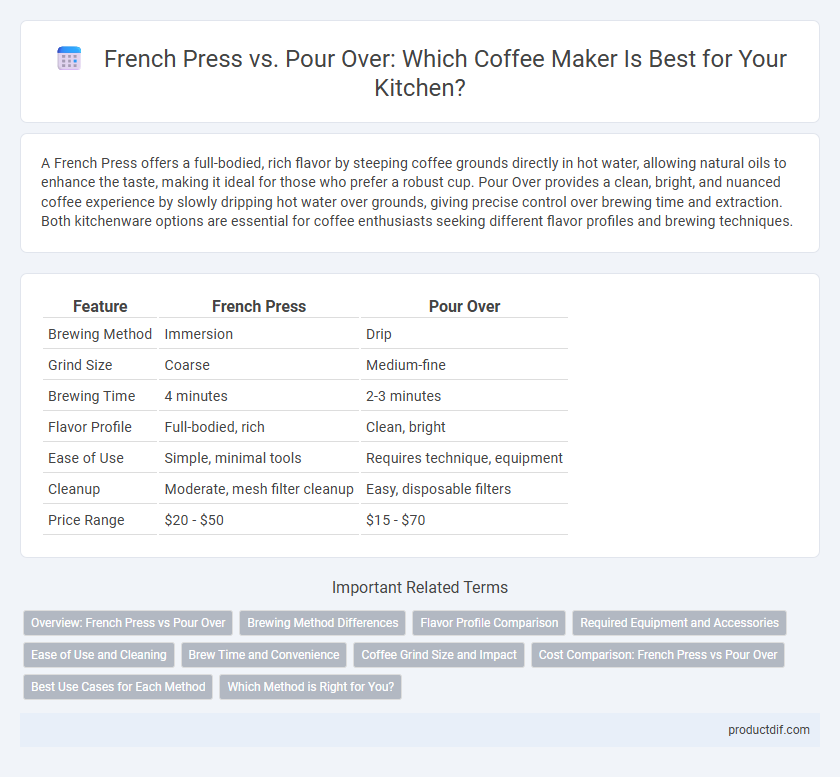A French Press offers a full-bodied, rich flavor by steeping coffee grounds directly in hot water, allowing natural oils to enhance the taste, making it ideal for those who prefer a robust cup. Pour Over provides a clean, bright, and nuanced coffee experience by slowly dripping hot water over grounds, giving precise control over brewing time and extraction. Both kitchenware options are essential for coffee enthusiasts seeking different flavor profiles and brewing techniques.
Table of Comparison
| Feature | French Press | Pour Over |
|---|---|---|
| Brewing Method | Immersion | Drip |
| Grind Size | Coarse | Medium-fine |
| Brewing Time | 4 minutes | 2-3 minutes |
| Flavor Profile | Full-bodied, rich | Clean, bright |
| Ease of Use | Simple, minimal tools | Requires technique, equipment |
| Cleanup | Moderate, mesh filter cleanup | Easy, disposable filters |
| Price Range | $20 - $50 | $15 - $70 |
Overview: French Press vs Pour Over
The French Press features a metal mesh plunger that immerses coffee grounds directly in hot water, producing a rich, full-bodied brew with robust flavors and oils. The Pour Over method uses a paper filter and slow, controlled pouring, resulting in a clean, bright cup with nuanced flavors and crisp acidity. Both techniques highlight distinct coffee profiles, with the French Press emphasizing depth and texture while the Pour Over accentuates clarity and brightness.
Brewing Method Differences
The French Press uses immersion brewing, where coffee grounds steep in hot water for several minutes, extracting bold flavors and oils for a rich, full-bodied cup. Pour Over employs a drip method, pouring hot water over coffee grounds in a filter, allowing gravity to pull the coffee through, resulting in a cleaner, brighter taste with distinct clarity. Temperature control and brew time vary significantly between the two, impacting the extraction process and flavor profile of the final coffee.
Flavor Profile Comparison
French Press brewing produces a rich, full-bodied flavor with robust oils and thicker texture due to its metal mesh filter, allowing more coffee oils and fine particles into the cup. Pour Over offers a cleaner, brighter flavor profile with heightened acidity and clarity, as its paper filter captures most oils and sediment. The choice between them hinges on preference for bold, intense coffee versus a crisp, nuanced cup.
Required Equipment and Accessories
A French Press requires minimal equipment, typically just the press itself and coarse ground coffee, making it ideal for simplicity and portability. Pour Over coffee demands more accessories including a dripper (such as a V60 or Chemex), filter papers, and a gooseneck kettle for precise water control. Accurate measurements with a scale and a timer are often used in pour over brewing to ensure consistent extraction and flavor.
Ease of Use and Cleaning
French Press coffee makers offer straightforward operation with a simple plunge mechanism, making them easier to use for beginners compared to pour-over brewers that require manual pouring control. Cleaning a French Press involves disassembling the plunger and rinsing multiple parts, which can be more time-consuming than the minimal rinsing needed for a single-piece pour-over dripper. The pour-over method's fewer components provide quicker cleanup but demand more precision during brewing for consistent results.
Brew Time and Convenience
The French Press typically requires around 4 minutes of brew time, offering a straightforward steep-and-press method that suits busy mornings. In contrast, Pour Over demands more attention and precision, with a brew time of approximately 3 to 4 minutes, making it ideal for those who enjoy a hands-on brewing experience. French Press excels in convenience due to its simple operation and minimal equipment, while Pour Over appeals to coffee enthusiasts prioritizing control over extraction and flavor nuances.
Coffee Grind Size and Impact
French Press requires a coarse coffee grind to prevent grounds from passing through the metal mesh filter, resulting in a rich, full-bodied brew with higher sediment content. Pour Over demands a medium-fine grind to ensure optimal extraction and balanced flavor clarity, as the paper filter traps oils and fine particles. Grind size directly impacts brew strength, extraction time, and overall taste profile in both methods.
Cost Comparison: French Press vs Pour Over
French Press coffee makers typically range from $20 to $100 depending on brand and materials, offering an affordable entry point for quality brewing. Pour over setups, including dripper, filters, and kettle, can vary widely from $15 to over $150, influenced by specialty equipment and design. Overall, French Presses provide a cost-effective option for consistent coffee extraction, while pour over systems may require higher initial investment for precision brewing tools.
Best Use Cases for Each Method
French Press delivers a robust, full-bodied coffee by steeping grounds directly in hot water, ideal for those who prefer rich flavors and a thicker texture, making it perfect for leisurely mornings or small group servings. Pour Over emphasizes clarity and brightness by filtering water through coffee grounds slowly, appealing to coffee enthusiasts who value precise control over brewing time and extraction, suitable for single cups with nuanced flavor profiles. Both methods excel in different scenarios: French Press for bold, immersive experiences and Pour Over for clean, detailed taste exploration.
Which Method is Right for You?
Choosing between a French Press and a Pour Over depends on your preferred coffee taste and brewing experience. The French Press offers a rich, full-bodied flavor with a robust coffee grind that retains oils and sediment, ideal for those who enjoy a heavier cup. Pour Over delivers a cleaner, brighter profile by filtering out oils and sediments, perfect for coffee enthusiasts who value precision and control over extraction time and temperature.
French Press vs Pour Over Infographic

 productdif.com
productdif.com